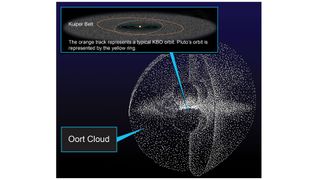What is the coldest place in the solar system?
And how does the coldest place on Earth compare?

Space is very, very cold. The baseline temperature of outer space is 2.7 kelvins — minus 454.81 degrees Fahrenheit, or minus 270.45 degrees Celsius — meaning it is barely above absolute zero, the point at which molecular motion stops.
But this temperature is not constant throughout the solar system. So-called "empty" space — though it is not actually empty — is far colder than planets, moons or asteroids, for example, because there is (practically) nothing to absorb the energy coming from the sun.
So, not including regular "empty" space, what is the coldest place in the solar system? And how does it compare with temperatures on Earth?
Related: What's the coldest place in the universe?
Measuring space
First, let's take a moment to consider exactly how cosmic temperatures are taken.
"Temperatures can be measured by observing the intensity of infrared and microwave radiation emitted from surfaces," Ian Crawford, a professor of planetary science and astrobiology at Birkbeck, University of London in the United Kingdom, told Live Science in an email. "In the absence of such measurements, temperatures can be estimated based on the amount of sunlight they receive."
However, taking cosmic measurements isn't always simple. According to Don Pollacco, a professor of astronomy at the University of Warwick in the United Kingdom, "nothing is ever straightforward in astronomy, mainly because you are always observing, as opposed to interacting."
So, although there are accurate ways to measure temperatures in space, there will always be room for refinement. "Temperatures are estimates," Pollacco said. "The numbers you calculate depend on how good your assumptions really are and how detailed the physical model is that you are using."
So, with those points in mind, what is the coldest place in the solar system, at least according to current data? Pluto, perhaps, given its distance from the sun?
In fact, the coldest place might be much closer to home.
To the moon
In 2009, the Lunar Reconnaissance Orbiter, a NASA robotic spacecraft designed to help scientists better understand conditions on the moon, presented data suggesting that "shadowed craters" at the lunar south pole could be the coldest place in the solar system.
This theory was later reinforced by graduate student Patrick O'Brien and his adviser Shane Byrne, planetary researchers at the University of Arizona. During a talk at the 2022 Lunar and Planetary Science Conference, O'Brien and Byrne suggested that "doubly shadowed" moon craters could indeed be "the coldest locations in the solar system."
According to O'Brien and Byrne, a crater can be regarded as doubly shadowed if it is "shielded not only from direct solar illumination but also from secondary heating sources," such as "solar radiation reflected off nearby illuminated areas as well as thermal radiation emitted from those warm surfaces."
Pollacco added that "doubly shadowed" craters "have high enough rims that sunlight never reaches the crater floor," which is why they are so cold.
O'Brien and Byrne's research suggests that, given these "permanently shadowed regions" have been "shielded" from solar illumination for billions of years, their craters could contain "micro-cold traps" that contain "not only water ice, but also more volatile compounds and elements," such as carbon dioxide, carbon monoxide, dinitrogen, and argon.
Related: What is the coldest city in the world?
According to O'Brien and Byrne, these craters are estimated to have temperatures of around 25 kelvins (minus 414.67 F, or minus 248.15 C), but they could be colder.
Crawford is confident in the veracity of the research. "I'm sure these are the coldest temperatures in the inner solar system [from Mercury to Mars] and also colder than the estimated average surface temperature of Pluto," he said.
The average surface temperature of Pluto, for context, is 40.4 kelvins, which is minus 386.95 F or minus 232.75 C, according to NASA.
However, these doubly shadowed moon craters may not be as cold as the Oort cloud, a shell of icy space debris located way beyond the orbit of Neptune, Crawford said. The distinction depends, he noted, on whether we include the Oort cloud when discussing the solar system.

The Oort cloud is at once considered to be the "most distant region of our solar system" by NASA, but also "beyond" our solar system. This lack of clarity means it is sometimes regarded as part of the solar system, and at others defined as the boundary between our solar system and interstellar space. The Oort cloud is considered to only be '"loosely bound to the solar system," according to ThePlanets.org.
According to Northwestern University in Illinois, temperatures in the Oort cloud could be as cold as 5 kelvins (minus 450.67 F or minus 268.15 C), which would be far colder than any temperature found on our moon.
However, if we don't include the Oort cloud, the coldest place in the solar system is very likely to be found on our nearest celestial neighbor.
Earth comparisons
On Earth, even the coldest, most punishing Antarctic temperatures are far warmer than either the moon's craters or the Oort cloud. The coldest terrestrial temperature ever recorded — registered on July 21, 1983, at Russia's Vostok research station in Antarctica — was minus 128.6 F (minus 89.2 C), according to the World Meteorological Organization's World Weather & Climate Extremes Archive.
However, scientists have artificially created temperatures that are lower than those that occur naturally on Earth, in the moon's craters or even in the Oort cloud. Last year, a team of German researchers broke the record for the coldest temperature reached in a laboratory: a chilling minus 459.67 F (minus 273.15 C), which they achieved by "dropping magnetized gas 393 feet (120 meters) down a tower."
But when it comes to temperatures that occur naturally, the darkest, most shadowy recesses of our moon seem very likely to boast the lowest temperature in our solar system — depending, of course, on how you choose to classify the Oort cloud.
Originally published on Live Science.
Sign up for the Live Science daily newsletter now
Get the world’s most fascinating discoveries delivered straight to your inbox.

Joe Phelan is a journalist based in London. His work has appeared in VICE, National Geographic, World Soccer and The Blizzard, and has been a guest on Times Radio. He is drawn to the weird, wonderful and under examined, as well as anything related to life in the Arctic Circle. He holds a bachelor's degree in journalism from the University of Chester.
